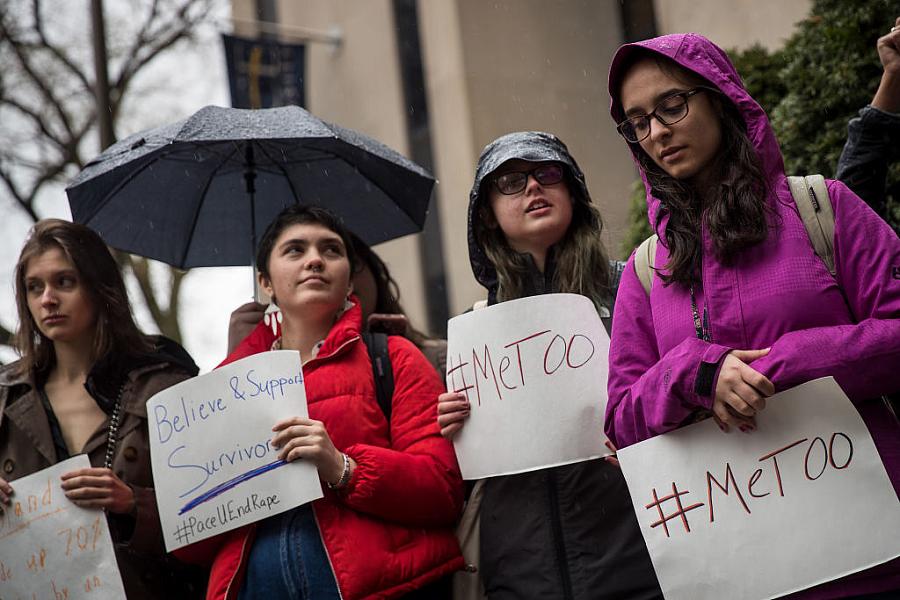The #MeToo movement hits California high schools

(Photo by Drew Angerer/Getty Images)
In 2020, a controversial new Title IX rule went into effect that offered new rights for those accused of sexual assault. It allowed both accused students and alleged victims to question each other during a live hearing and narrowed the definition of sexual assault. Meanwhile, high school students are resorting to unofficial reporting channels, and using Twitter and Instagram to seek justice on their own terms outside the purview of administrators.
This past summer in particular, students across California and the nation began creating Twitter and Instagram accounts to share experiences anonymously about racial discrimination, bullying, and sexual assault at their schools. Through these online networks, students and alumni are naming alleged perpetrators and creating their own virtual spaces to tell stories of sexual assault and trauma.
This comes as reports of sexual violence in elementary and secondary schools are rising, according to data released in October by the U.S Department of Education’s Office for Civil Rights. The same data shows California has the ninth-highest rates of reported incidents of rape or attempted rape in schools in the nation.
Some schools have responded to these social media campaigns and student-led activism by inviting student leaders into discussions or committees tasked with revising consent education. In some cases, schools and police launched investigations into the people accused online. But these social media campaigns are also complicated. Some of the students running these campaigns have faced legal threats and online bullying, and the people accused have little recourse for responding to the allegations against them.
This suggests a bigger problem. Why are students turning to social media to report sexual harm rather than parents or school administrators? What does the typical process for filing Title IX complaints look like, and what happens when students do report abuse online? Can these social media campaigns lead to lasting change, or does the momentum fade within weeks? What is the impact for the students and teachers who are accused?
These are some of the questions I will answer, as a 2021 Impact Fund recipient, through the lens of at least three different schools: San Francisco’s Lowell High School, Berkeley High School, and Skyline High School in Oakland. Each Bay Area school typifies a different racial, economic, and cultural experience of education.
Lowell High School is an elite school in San Francisco known for its competitive admissions process. Berkeley High School is a public school with a long history of student-led activism on segregation, environment justice, and in recent years, sexual abuse. Skyline High School is a public school in Oakland, a district where students of color were directly involved in shaping a new policy around how schools prevent and respond to sexual harassment and assault.
I plan to obtain data to understand how often harassment and assault are reported at these and other schools in California, and explore the processes by which these administrators respond when allegations are made. Because many student-activists call for more comprehensive consent education, I’ll outline the kinds of education around sexual harassment and assault offered by these schools and how it’s changed over the years.
While building an understanding of the systems in place, I’ll be reaching out to people
to share their experiences reporting allegations of abuse to administrators and what happened when they did. I’ll also be speaking with people who didn’t report sexual misconduct to their schools about some of the barriers to doing so. I’ll examine why this online phenomenon reached a fever pitch during the pandemic, and how online learning affects students’ abilities to organize, and schools’ ability to respond.
My goal is to interview people who have been accused of harassment and assault as well as alleged victims. While many of the people accused are no longer teenagers, many of the alleged allegations took place while they were in high school years ago. In some cases, the people accused are still teenagers, and I’m hoping to speak with them and their families for both a response to the allegations, as well as the impact being accused has had on them.
The Instagram accounts teenagers have set up to anonymously post allegations of sexual assault or other kinds of abuse are not an isolated phenomenon. It fits in a broader, highly contentious trend of reporting abuse or mistreatment online across multiple industries and institutions. It’s worthwhile to understand what happens when unofficial reporting tools are used by teenagers and high school graduates, and why.

